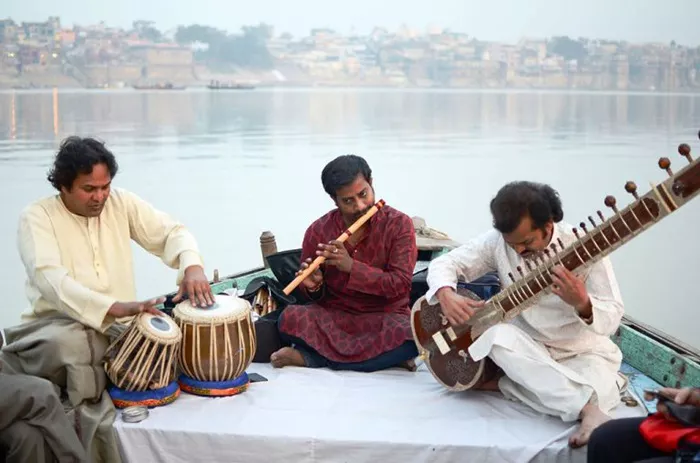India, with its diverse cultural heritage and deep-rooted musical traditions, boasts a rich tapestry of classical music that has evolved over centuries. This article delves into the intricate world of Indian classical music, exploring its various types, styles, and regional variations.
Understanding Indian Classical Music
Indian classical music is a complex and highly structured art form that has been passed down through generations via oral tradition and rigorous training. It is deeply rooted in ancient scriptures and has two main branches: Hindustani and Carnatic.
1. Hindustani Classical Music
Hindustani classical music is predominantly practiced in North India and has its roots in the Vedic chants and ancient musical treatises like the Natya Shastra. It is characterized by a rich improvisational tradition and a vast repertoire of ragas (melodic frameworks) and talas (rhythmic cycles). Some of the key elements of Hindustani classical music include:
Ragas: Ragas are the backbone of Hindustani classical music. They are melodic frameworks that define the mood, emotions, and characteristics of a musical composition. Ragas are based on a series of specific notes arranged in ascending (aaroha) and descending (avaroha) order.
Talas: Talas refer to rhythmic cycles or patterns that govern the timing and structure of a musical composition. Common talas in Hindustani classical music include Teental (16 beats), Dadra (6 beats), Rupak (7 beats), and Jhaptaal (10 beats).
Gharanas: Gharanas are stylistic schools or traditions within Hindustani classical music. Each gharana has its unique approach to raga rendition, improvisation techniques, and repertoire. Some prominent gharanas include the Gwalior, Agra, Jaipur, and Kirana gharanas.
Instruments: Hindustani classical music is performed using a variety of instruments, including the sitar, sarod, tabla, harmonium, flute, and violin. Each instrument brings its own tonal quality and expressive capabilities to the music.
2. Carnatic Classical Music
Carnatic classical music, on the other hand, is primarily practiced in South India, particularly in the states of Tamil Nadu, Karnataka, Kerala, and Andhra Pradesh. It has ancient roots in the Vedic traditions and is characterized by its intricate compositions, rhythmic complexity, and emphasis on precise intonation. Key aspects of Carnatic classical music include:
Krithis: Krithis are structured compositions in Carnatic music that encompass both melody (raga) and rhythm (tala). They often have lyrical content in classical languages like Telugu, Tamil, Kannada, or Sanskrit and are composed in various musical forms such as varnams, kirtanas, and padams.
Ragas: Similar to Hindustani music, Carnatic music also revolves around ragas. However, Carnatic ragas may have subtle differences in their scale, ornamentation, and usage compared to their Hindustani counterparts.
Talas: Talas in Carnatic music are rhythmic cycles that govern the structure and flow of compositions. Common talas include Adi Tala (8 beats), Rupaka Tala (6 beats), Misra Chapu (7 beats), and Khanda Chapu (5 beats).
Instruments: Carnatic classical music utilizes a range of traditional instruments such as the veena, violin, mridangam, ghatam, kanjira, and flute. Percussion instruments like the mridangam play a crucial role in providing rhythmic support and improvisational exchanges during performances.
Regional Variations and Folk Influences
Beyond the broad categories of Hindustani and Carnatic classical music, India’s musical landscape is further enriched by a myriad of regional variations and folk influences. Each region in India has its unique musical traditions, folk songs, and dance forms that contribute to the country’s cultural mosaic.
North Indian Folk Music: In North India, folk music traditions like Baul, Bhatiali, Qawwali, and Thumri have deeply influenced classical music styles. These folk forms often express themes of love, devotion, nature, and social commentary through simple yet evocative melodies and rhythms.
South Indian Folk Music: South India boasts a vibrant array of folk music genres such as Lavani, Kolattam, Oppana, and Yakshagana. These folk forms are characterized by energetic dance movements, rhythmic percussions, and narrative storytelling, reflecting the local customs and traditions of the respective regions.
East Indian Folk Music: The eastern regions of India, including West Bengal, Odisha, and Assam, have their own folk music traditions such as Bihu, Jhumur, and Bhatiali. These folk forms often accompany seasonal festivals, agricultural rituals, and social gatherings, serving as a cultural bridge between communities.
West Indian Folk Music: Western India is home to diverse folk music styles like Garba, Dandiya, Lavani, and Koli music. These folk forms celebrate life events, harvest festivals, and historical narratives, showcasing the vibrant cultural heritage of states like Gujarat, Maharashtra, and Rajasthan.
Fusion and Contemporary Expressions
In recent years, Indian classical music has embraced fusion and contemporary expressions, blending traditional elements with modern innovations. This fusion movement has led to collaborations between classical musicians and artists from diverse genres such as jazz, rock, electronic, and world music.
Fusion Ensembles: Bands and ensembles like Shakti (featuring Zakir Hussain and John McLaughlin), Remember Shakti, and Indian Ocean have pioneered fusion music by blending classical ragas, rhythms, and improvisational techniques with Western instruments and musical idioms.
Experimental Projects: Experimental projects and collaborations between classical vocalists, instrumentalists, and electronic music producers have pushed the boundaries of traditional music, exploring new sonic landscapes and creative possibilities.
Global Outreach: Indian classical musicians and dancers have gained international acclaim, performing at prestigious venues and festivals worldwide. This global outreach has facilitated cultural exchanges, cross-genre collaborations, and a renewed interest in Indian classical arts among global audiences.
Conclusion
In conclusion, the diversity and depth of classical music in India reflect the country’s rich cultural legacy, artistic innovation, and enduring traditions. From the intricate melodies of Hindustani and Carnatic ragas to the rhythmic vibrancy of folk music and the fusion explorations of contemporary artists, Indian classical music continues to evolve and captivate audiences across the globe. It serves as a testament to the timeless beauty and transcendent power of music in connecting hearts and souls across boundaries.
Through centuries-old traditions, regional variations, and innovative expressions, Indian classical music remains a vibrant and living art form that embodies the essence of creativity, spirituality, and cultural heritage.

